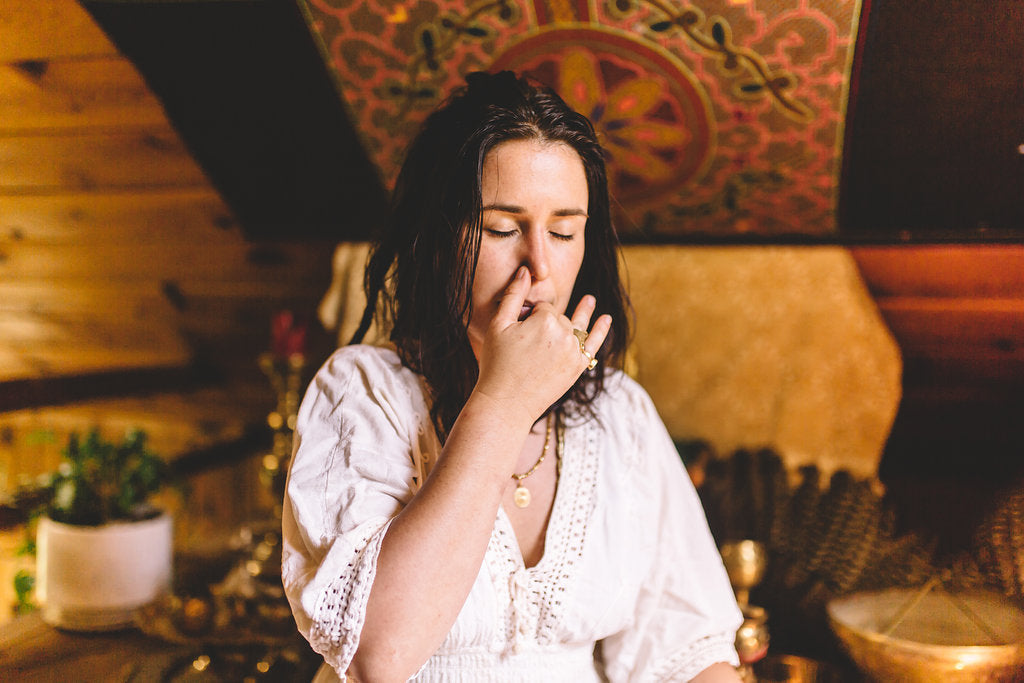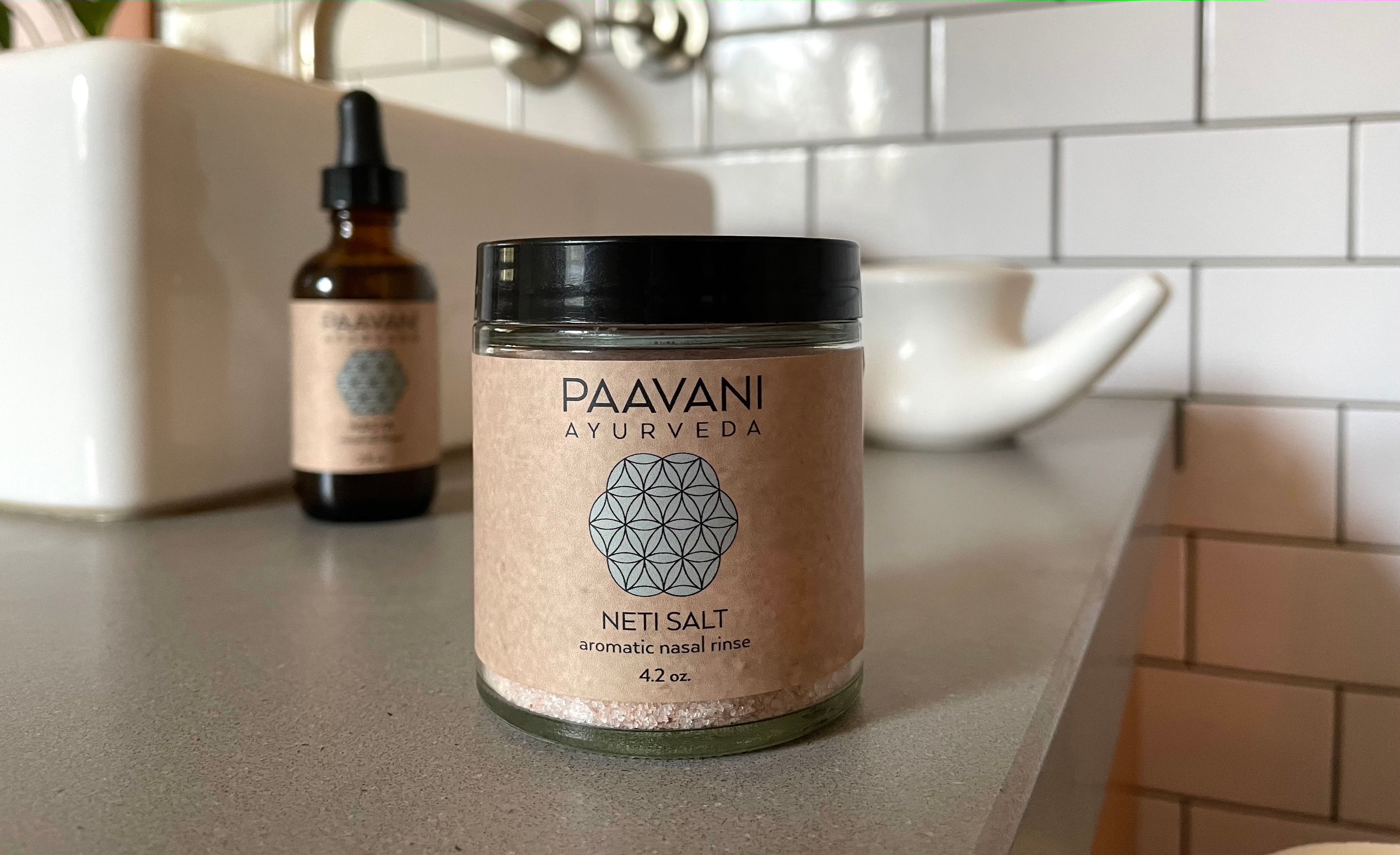
Pranayama for Balancing Kapha Dosha
Ayurveda, India’s 5,000 year old medical system, provides a wealth of information on how to integrate healthy, mindful rituals into your day in order to keep your body and mind balanced. This ancient, holistic healing system, unlike the Western allopathic model of medicine, has a strong focus on preventative care. Through the practices of Ayurveda we are given the necessary tools and knowledge so that we may become our own healer, allowing us to advocate daily for our health and well-being. Furthermore, its practices help to keep us free from disease and ailments. Dinacharya, the Sanskrit term for daily Ayurvedic rituals, are practices we can implement into each day to detoxify, nourish and care for ourselves, while also remaining connected to the circadian rhythms of nature. For a full list of dinacharya practices, please visit our Dinacharya page.
What is Pranayama?
One dinacharya ritual outlined in Ayurveda is pranayama. Pranayama is a Sanskrit term that can be broken down into two words, prana and ayam. Prana is breath, it is our life force energy. Ayam means to control. We need prana in order to have fresh oxygen move into the body and give us life and vitality. It is also prana that awakens us to our spiritual goals and dharma. We need ayam to control our prana and direct our energy to where we need it to go. When pranayama is practiced daily, the mind awakens, energy is cultivated and balance is maintained.
There are many pranayama practices to choose from and, from the Ayurvedic perspective, it is important to learn about the effects on each dosha prior to implementing them. Below, we explore which pranayama or breathing exercises restore balance to kapha dosha. First and foremost, let’s look at kapha dosha in general.
What is Kapha Dosha?
Kapha dosha is comprised of the water and earth elements. Every living being contains kapha dosha; however, we all have varying amounts of kaphaand that is what makes us all unique. Kapha is connected with the spring because this is when earth and water are abundant in the natural world. Spring showers saturate the earth with nourishing energy (water) and new life emerges (earth). Furthermore, kapha is connected with the ideas of rebirth and renewal.
Since kapha is the most abundant in the spring, it is easier for this dosha to increase to an unhealthy level within the body and mind during this time of year. When kapha dosha becomes imbalanced, water and earth can create stickiness, congestion, dullness and heaviness in the physical body and mind.
Some symptoms of excess kapha include:
- congestion
- mucus accumulation
- constipation due to low peristaltic action
- nausea
- lethargy
- weight gain
- swelling / water retention
- feeling cold or having chills
- poor circulation
- oily and/or congested skin
- cystic acne
- difficulty waking in the AM
- brain fog
- lack of motivation
- melancholy
- depression
- attachment
There are specific pranayama practices that can counterbalance the symptoms outlined above. The focus of kapha balancing pranayama is to bring in light, warming, activating and purifying energy in order to reduce the congestion, heaviness, stickiness and dullness that excess kapha can create.
Three of the best breathing exercises to restore balance to kapha dosha are Nadi Shodhana, Kapalabhati and Bhastrika.
PRODUCTS FOR BALANCING KAPHA
Ayurvedic Preparation for Pranayama
Before you begin your pranayama, Ayurveda recommends the rituals of neti and nasya in order to enhance the flow of prana and your ability to take a full deep breath. Neti is the practice of cleansing the nasal passageways with a blend of warm, purified water and salt. Our PAAVANI Neti Salt blends Himalayan salt with essential oils of eucalyptus, peppermint, rosemary and tea tree, to provide you with an aromatic saline solution for your neti ritual. After you neti remember to always follow with nasya. Nasya is the practice of applying herbal infused Nose Oil into the nasal passageways in order to further clear, hydrate and protect the nose from environmental pollutants and pathogens.
Nadi Shodhana
Nadi Shodhana, also known as Alternate Nostril Breathing, is a tridoshic pranayama, meaning that it balances all three doshas- vata, pitta and kapha. It also purifies and restores balance to both the Pingala and Ida Nadis, or subtle energy channels of the body. The Pingala Nadi is an energy channel within the subtle body that is connected with solar or sun energy. It is present on the right side of the body and left side of the brain. When your Pingala Nadi is activated during Nadi Shodhana, divine masculine energy is stimulated. The Ida Nadi is an energy channel within the subtle body connected with lunar or moon energy. It is present on the left side of the body and right side of the brain. When your Ida Nadi is activated during Nadi Shodhana, divine feminine energy is enhanced. In short, the practice of Nadi Shodhana helps to gently stimulate, cleanse and balance the male and female energies inherent within each of our bodies. It also balances both hemispheres of the brain and removes blockages to flow in the subtle energy channels.
Benefits of Nadi Shodhana for Kapha Dosha
- Clears the mind
- Increases alertness
- Balances female and male energetics
- Detoxifies the body
- Brings in prana rich oxygen
- Relieves allergies and congestion in the respiratory system

How to do Nadi Shodhana
- Find sukhasana or a comfortable seated position on the floor, preferably with your pelvis elevated by one or two folded blankets underneath your sitting bones. This method helps ensure your spine is straight and you are in proper alignment.
- Close your eyes and take 3 steady, deep breaths.
- Bring your left hand to chin mudra by placing your thumb and index finger together. Rest the back of your left palm on your left thigh.
- Bring your right hand to vishnu mudra by curling your index and middle fingers down into your right palm while your thumb, ring finger and pinky finger stay extended.
- Draw your right hand up to your right nostril, gently close your right nostril with your thumb.
- Slowly draw air into your left nostril for 3 seconds.
- Retain the breath by keeping your right nostril closed with your thumb and gently close the left nostril with your ring and pinky finger. Retain or hold the breath for 9 seconds.
- Keep your left nostril closed with your ring finger and release your thumb to slowly exhale out through the right nostril for 6 seconds.
- Keep your left nostril closed and slowly inhale through your right nostril for 3 seconds.
- Retain the breath by keeping your left nostril closed with you ring and pinky finger and gently close your right nostril with your thumb. Retain or hold the breath for 9 seconds.
- Keep your right nostril closed and release your ring and pinky finger to slowly exhale out through your left nostril for 6 seconds.
- This completes one full round of Nadi Shodhana.
- Repeat this process for 3-10 rounds.
- Remember to keep the breath fluid, smooth, relaxed and gentle.
How long should Nadi Shodhana take?
We recommend 3-10 rounds of this pranayama each day. A few rounds can take around 5 minutes, which will provide benefits to the body and mind; however, practicing for longer, up to 20 to 30 minutes per day, will enhance its benefits.
Contraindications for Nadi Shodhana
Nadi Shodhana is not recommended if you have recently undergone abdominal, brain or heart surgery. Also, if you are experiencing discomfort in the exercise, reduce the duration of the breath.
Kapalabhati
Commonly known as Skull Shining Breath, Kapalabhati is actually a kriya or cleansing technique utilized in Ayurveda and Yoga to purify and uplift. Kapalabhati helps to stimulate circulation and warm the cold, stagnant qualities of kapha dosha. It also circulates prana, bringing fresh, life force energy to the mind. In turn, this reduces the heavy and dense qualities of kapha that can make us feel unmotivated, lethargic and depressed. Lastly, kapalabhati is a wonderful way to stoke jatharagni, the fire contained within the digestive tract that is necessary to digest and assimilate food in a timely manner. When jatharagni is low, kapha dosha can become excessive and lead to sluggish digestion and mucus accumulation in the digestive tract. If this is currently happening, kapalabhati is an ideal pranayama to help get jatharagni back to a healthy level.

How to Do Kapalabhati
- Find sukhasana or a comfortable seated position on the floor, preferably with your pelvis elevated by one or two folded blankets underneath your sitting bones. This method helps ensure your spine is straight and you are in proper alignment.
- Place your hands in chin mudra. To create this mudra, bring your index finger and thumb of your left and right hands together and then rest the back of your hands on your thighs.
- With your hands in chin mudra, close your eyes and take 3 steady, deep breaths.
- Take a deep inhale through your nose, inhaling ¾ of the way, filling up your belly with breath.
- Exhale forcefully through your nose and simultaneously draw the navel back inward towards your spine.
- Allow your lungs to fill up naturally, allowing the inhale to be passive.
- Immediately following the passive inhale, begin the cycle again.
- The cycle of kapalabhati is rapid, with one exhale per second.
- Repeat 20 cycles.
- At the 20th exhale, slowly exhale through your nose, expelling all of the air out of your body.
- Inhale ¾ of the way and retain the breath.
- Only retain the breath for as long as is comfortable without strain.
- Exhale completely through your nose.
- Breathe normally, enjoying the cleansing, energizing benefits.
- Repeat this process 1-2 more times.
What if I am having a hard time expelling the exhale from my abdomen?
Bring your hands to your abdomen and let them stay there. Inhale through your nose and take a strong, sharp exhale out of your mouth, like you would to fog up a mirror. Repeat that a few times, allowing the inhale to be passive, focusing solely on the sharp exhale through your mouth. As you exhale, your hands should feel the belly snapback in a motion that pumps the air out. That is the exact movement you want for kapalabhati; however, your mouth will be closed rather than open.
Contraindications for Kapalabhati
Kapalabhati is considered an advanced breathing technique and is best practiced with an experienced yoga teacher. Avoid doing this pranayama on a full stomach. We recommend waiting at least 2 hours after a meal to do Kapalabhati. If you recently had abdominal surgery, or are experiencing gastric ulcer, heart disease, high or low blood pressure, vertigo, migraine headache, detached retina, nosebleeds, are pregnant or on your moon cycle, kapalabhati is not recommended. Also, if you begin to feel dizzy or anxious during the pranayama, please slow down to find a calm, sustainable pace or discontinue the practice.
Bhastrika
Similar to Kapalabhati, Bhastrika, or Bellow’s Breath, assists in warming the body, circulating prana and kindling jatharagni. This activating pranayama is an excellent way to slough off the cloudy, cool, heavy and dense energy of kapha dosha that can infiltrate the mind and leave you feeling unmotivated, uninspired and downright lazy! In our opinion, Bhastrika is the yoga equivalent of having a cup of coffee. It helps with clarity, alertness and restoring joy and enthusiasm within the mind.
How to Do Bhastrika
- Find sukhasana or a comfortable seated position on the floor, preferably with your pelvis elevated by one or two folded blankets underneath your sitting bones. This method helps ensure your spine is straight and you are in proper alignment.
- Close your eyes and take 5 steady, deep breaths.
- Inhale drawing your breath into the diaphragm while simultaneously reaching your arms up and overhead, with the palms open and fingers spread.
- Exhale forcefully out through your nose while simultaneously drawing your arms down by bending your elbows in and curling your fingers into the palms of your hands to make a fist with your palms facing out. When your arms are fully contracted down, your palms should be at shoulder height.
- Continue steps 3 & 4 for 20-30 rounds of breath.
- Towards the end of the pranayama, you can increase the speed for the last 10 rounds of breath.
- Begin to slow the breath back down.
- Return back to sukhasana with your hands in a comfortable position.
- Breathe normally, tuning into the clarifying, uplifting and activating energy you cultivated.
Contraindications for Bhastrika
Bhastrika is considered an advanced breathing technique and is best practiced with an experienced yoga teacher. Avoid doing this pranayama on a full stomach. We recommend waiting at least 2 hours after a meal to do Bhastrika. If you recently had abdominal surgery, or are experiencing gastric ulcer, heart disease, high or low blood pressure, vertigo, migraine headache, detached retina, nosebleeds, are pregnant or on your moon cycle, Bhastrika is not recommended. Also, if you begin to feel dizzy or anxious during the pranayama, please slow down to find a calm, sustainable pace or discontinue the practice.
Make Space for You
During hectic days and weeks that seem to fly by, sometimes sitting down and taking time to do pranayama seems almost impossible. Yet, just 3-5 minutes of breath awareness can jumpstart your day, relieve your mid-afternoon energy slump or get you motivated to take action and manifest your innermost desires. Plus, these breathing techniques can literally be done anywhere! This spring, may the light, warming and revitalizing energy of kapha balancing pranayama ignite joy within and guide you back to your true nature!
To find Ayurvedic products formulated specifically to balance kapha dosha, check out our Kapha Skincare & Wellness Products.





Leave a comment
This site is protected by hCaptcha and the hCaptcha Privacy Policy and Terms of Service apply.